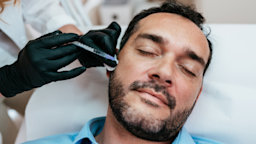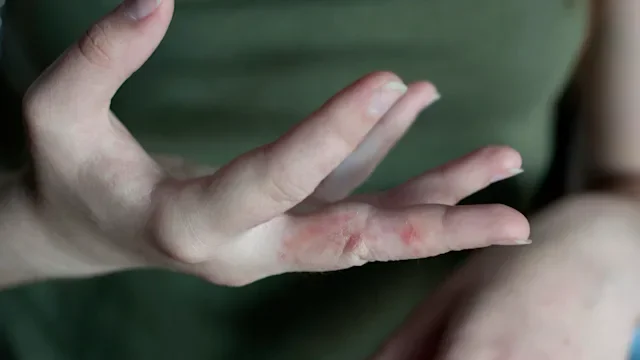Key takeaways:
Dermal fillers are injected under the skin to smooth lines or add fullness to the face or hands.
Botox (onabotulinumtoxinA) is injected into specific muscles to relax them. It can be used to flatten wrinkles as well as a number of other medical conditions.
The side effects of dermal fillers and Botox are usually mild. But they can have some serious risks if they’re not administered properly.
Save on related medications
Dermal fillers and Botox Cosmetic (onabotulinumtoxinA) injections are popular cosmetic treatments. They can be given during an office visit. And in most cases, they don’t require recovery time after administration.
Both treatments can help reduce signs of aging by smoothing facial lines. Dermal fillers can also add fullness to the face or hands and help with scarring. Plus, other versions of Botox have many other medical uses beyond wrinkles.
You may have questions about how effective and safe these treatments are. Below, we'll discuss the various uses, side effects, risks, and costs of dermal fillers and Botox.
Search and compare options
What is Botox?
Botox Cosmetic (onabotulinumtoxinA) is an injectable medication that’s made of toxins from a bacteria called Clostridium botulinum. At high doses, this toxin can cause a serious infection known as botulism. But Botox injections are given in very small doses and isolated to certain muscles. So, botulism is very rare if the injections are administered properly.
Botox works by blocking nerves and temporarily stopping the muscle where it’s injected from contracting. It’s commonly used for cosmetic purposes like smoothing facial lines.
A few products that are similar to Botox Cosmetic include Dysport (abobotulinumtoxinA), Xeomin (incobotulinumtoxinA), Jeuveau (prabotulinumtoxinA-xvfs). These all can treat facial wrinkles.
What are dermal fillers?
Dermal fillers are injections given under the skin meant to smooth wrinkles or add fullness to the hands or face. Both temporary and longer-lasting dermal filler options are available. They’re considered to be medical devices — not medications.
Some fillers are temporary because the injected substances will be broken down and absorbed by your body over time. FDA-approved fillers are made of one of three substances: hyaluronic acid, calcium hydroxylapatite, or poly-L-lactic acid (PLLA).
Examples of temporary fillers include:
Hyaluronic acid: Juvederm, Restylane, and Captique
Calcium hydroxylapatite: Radiesse
Poly-L-lactic acid (PLLA): Sculptra
Read more like this
Explore these related articles, suggested for readers like you.
There’s also a synthetic dermal filler formulation that isn’t absorbed by the body. This makes it a more permanent treatment option. It’s made of smooth, plastic beads called polymethylmethacrylate (PMMA) beads. Bellafill is the only FDA-approved PMMA filler available. Its results can last for up to 5 years.
What are the differences between Botox and dermal fillers?
While dermal fillers and Botox injections can both be used to treat facial wrinkles, they work differently to achieve this result. Who can use them, how long they last, and their side effects and risks are all slightly different.
Uses
Dermal fillers are implants that are injected under the skin (not into the muscle). They add volume to wherever they’re injected, helping create a smoother and fuller look.
Dermal fillers are FDA-approved for use in people age 22 years and older. They’re used to help with the following:
Moderate to severe facial wrinkles
Acne scars on the cheek
Loss of facial fat in people with HIV
Adding fullness to lips, cheeks, chin, jawline, under-eyes, and backs of hands
When used for cosmetic purposes, Botox is injected directly into specific facial muscles and works by relaxing them enough to improve the appearance of facial lines.
Botox Cosmetic is FDA-approved for use in adults at least 18 years old to help with the following:
Frown lines between the eyebrows
Crow’s feet lines
Forehead lines
While dermal fillers are mostly used for cosmetic purposes, other versions of Botox can be used to treat several medical conditions, including:
Muscle spasticity (stiffness)
Excessive sweating
Crossed eyes
Results
For dermal fillers, how long you’ll continue to see results depends on the specific product you receive:
Hyaluronic acid: Immediate results can last for up to 6 to 12 months.
Calcium hydroxylapatite: Immediate results can last for up to 18 months.
PLLA: Injections are given over the course of a few months, with results developing over several weeks. Effects can last up to 2 years.
PMMA: Immediate results with volume develop over time. Effects can last up to 5 years.
The results from Botox injections don’t last quite as long as dermal fillers. Usually, you'll see results for about 3 to 4 months after treatment. But this can vary. Many people will get repeated injections to maintain their results.
Side effects
Most of the side effects of dermal fillers are seen within a few days of the injection. They’ll usually go away after 1 to 2 weeks. But in some cases, they can appear even months or years later.
Some common side effects of dermal fillers are:
Bruising or redness
Pain or swelling
Rash or itching
Difficulty with some activities (when injections are given into the back of the hand)
Although rare, facial swelling has been reported in people who received an mRNA COVID-19 vaccine shortly after getting dermal filler injections. This reaction resolves easily with treatment. Contact your healthcare provider if you experience swelling where dermal fillers were injected.
Botox can cause similar side effects like bruising, swelling, and pain at the injection site. But it might also cause:
Facial weakness
Eyelid or brow drooping
Double vision
Dry eyes
Risks
Treatment with dermal fillers won’t usually cause serious problems if given by an experienced healthcare provider in a medical setting. You shouldn’t ever get dermal fillers outside of this professional setting.
If not administered correctly, dermal fillers could cause:
Lumps, ridges, or over-filled areas
Serious swelling
Skin discoloration
Infection
Allergic reaction (some fillers require allergy testing prior to treatment)
Although rare, another serious risk is if dermal fillers are injected into a blood vessel. This can result in severe tissue damage, blindness, or stroke.
There are also many unapproved dermal filler products on the market. This includes silicone injections, needle-free devices, and products sold directly to the public. These products may be fake, contaminated, and/or cause harm. Only get dermal filler injections given by an experienced healthcare provider in a medical setting.
Botox injections are usually well-tolerated. Although rare, they can also cause serious complications within hours or up to weeks after the treatment.
Botox can cause weakness in the muscles involved in speaking, breathing, and swallowing. This could possibly result in a feeding tube needed for eating and drinking, or even death from breathing complications.
In rare cases, the toxin in Botox may spread away from the injection site. This can result in botulism, which can be life-threatening. Symptoms include weakness all over the body, trouble speaking and breathing, and blurred vision.
Costs
Most people who get dermal fillers need more than one syringe per treatment. Data from 2020 shows the average cost of dermal fillers (per syringe) as follows:
Hyaluronic acid: $684
Calcium hydroxylapatite: $717
PLLA: $853
PMMA: $1,058
Botox is usually priced based on the number of units used. This can range from $10 to $15 per unit. The usual dose is 20 units for frown lines, 24 units for crow’s feet, and 20 units for forehead lines. Pricing could range from $300 to almost $1,000 for each appointment depending on injection sites.
Insurance typically doesn’t cover cosmetic procedures. So, dermal fillers and Botox probably won’t be covered. Botox is typically only covered if it’s being used to treat a medical condition.
The bottom line
Dermal fillers and Botox are common cosmetic treatments because they have fast results with little to no recovery time. The results can last anywhere from a few months to a few years, depending on which treatment you get.
Both dermal fillers and Botox can cause mild side effects like swelling, redness, or pain. And they should be administered by a trained healthcare professional in a medical setting to avoid serious complications.

Why trust our experts?



References
American Academy of Dermatology Association. (n.d.). Botulinum toxin therapy: overview.
American Academy of Dermatology Association. (n.d.). Fillers FAQs.
American Society of Plastic Surgeons. (n.d.). Dermal fillers cost.
American Society of Plastic Surgeons. (n.d.). Types of dermal fillers.
Allergan. (2021). Botox [package insert].
Allergan. (2021). Botox Cosmetic [package insert].
Centers for Disease Control and Prevention. (2021). Botulism.
Centers for Disease Control and Prevention. (2022). Interim clinical considerations for use of COVID-19 vaccines.
Evolus. (2021). Jeuveau [package insert].
Food and Drug Administration. (2020). FDA-approved dermal fillers.
Food and Drug Administration. (2021). Do not use needle-free devices for injection of dermal fillers – FDA safety communication.
Food and Drug Administration. (2021). Dermal filler do's and dont’s for wrinkles, lips and more.
Food and Drug Administration. (2021). Dermal fillers (soft tissue fillers).
Mariotti, E. (2019). What's behind the cost of Botox and injectable fillers? American Society of Plastic Surgeons.
Suneva Medical. (n.d.). Bellafill cosmetic.















